To begin with he was Austrian not German. Although all his film work prior to 1934 were made in Germany. He was born in Vienna “The City of Music”, or “The City of Dreams”. Take you pick one was named for the composers born in the city like Franz Schubert and Johann Strauss. The other because Vienna was also the birthplace of Sigmund Freud. The date of his birth was December 5, 1890 and his father Anton was an architect and construction company manager. His mother was named Pauline, but called “Paula” and his name was Fritz Lang.
It is interesting that like many early directors in the motion picture industry Fritz Lang started out in a different direction in his case after graduating from the “Technical University of Vienna” as a civil engineer. Shortly after receiving his degree Lang would switch from drawing technical specs to actual art. In 1910 he started traveling throughout Europe. Adding Africa and later Asia and the Pacific Islands. Three years after switching careers found Lang studying art in 1913 Paris.
At the outbreak of World War One Fritz Lang enlisted in the Austrian army and fought in both Russia and Romania against the Czar. In 1918 he was discharged with the rank of lieutenant after being wounded three times. Another short bio implied he was discharged not from several serious injuries as most state, but from being shell-shocked and unfit for duty. Whichever are the true events while convalescing in a military hospital Fritz Lang became interested in motion picture screenwriting and began writing them. His scripts were produced as early as 1917 prior to receiving his official military discharge. Lang would even try the boards as an actor in the Viennese theater during 1917 and 1918 prior to his official discharge.
Erich Pommer is considered the most important person in the budding German and European Film Industry during the 1920’s and 1930’s and one of the founders of the “Expressionist” movement. Pommer read Lang’s work and hired him initially as a writer for “Decia-Bioscop” in 1917. He would later take Lang with him to Ufa.

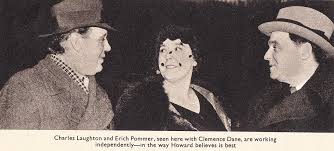
From the start of 1917 into mid 1918 Fritz Lang wrote the screenplays for five films and then Pommer decided to make him a director. We know the title of that first film with the screen credit directed by Fritz Lang and also written by him entitled “Halbblut (Half-Blood)” released April 3, 1919. We also know the cast of the movie, but we have no idea what the movie was about. Even the German Wikipedia has no specific details.
Halbblut (English: Half-blood) is a 1919 silent film directed by Fritz Lang. It was the first film Lang directed. The film starred Carl de Vogt, Ressel Orla, and Carl Gerard Schröder. It is presumed to be lost.
For September of 1919 Fritz Lang’s filmography mentions a 60 minute film “Der Herr der Liebe (The Master of Love)”. It is unique because it was the only film Lang directed, co-wrote and acted in a small role. The story is about a Hungarian nobleman named Vasile Disecu who becomes infatuated with Suzette, the daughter of his neighbor. He somehow mistakes Stefana, Suzette’s maid who is secretly in love with Vasile, for Suzette and makes love to her. When Yvette, his wife, finds out, she avenges herself with a liaison with Lazar, a Jewish peddler. Vasile imprisons Lazar. He then kills Yvette and commits suicide. One just loves a happy ending.

Also during 1919 Fritz Lang married Lisa Rosenthal. The first question to ask is who Lisa Rosenthal was, because there is no known history of her life. Only two facts remain to discuss about her. The first was she was Jewish and came from “Vilnius” in Russia. The second fact is that Lisa Rosenthal committed suicide, or maybe it wasn't a real fact because she was murdered by her husband Fritz Lang.
There are several articles on line about her death and the following paragraphs come from somebody name William Ahearn. (I tried to find out who he was, but the link took me to a page with all those “We found William Ahearn” links on it.)
http://www.williamahearn.com/lisa.html
http://www.williamahearn.com/lisa.html
The following is part of his article on the death of Lisa Rosenthal:
One reference that I found was in Robert A. Armour’s Fritz Lang, published by Twayne Publishers in 1977. Armour wrote, “[Fritz] Lang divorced his first wife and married [Thea] von Harbou.”
Lang didn’t divorce Lisa Rosenthal. Rosenthal died of a gunshot wound to the chest and therein hangs a tale that Lang left behind when he fled from Germany in 1933. The story is told in Patrick McGilligan’s Fritz Lang: The Nature of the Beast and the recap goes something like this: Thea von Harbou was married to actor Rudolf Klien-Rogge and when her affair with Lang – that was no secret to the film community – heated up, she moved out of her home with Klien-Rogge and moved into the same apartment building as Fritz Lang. One day Lisa Rosenthal comes home unexpectedly and finds Lang and Harbou engaged in “violent petting,” as Lang described it later, on the sofa. Shortly thereafter, Rosenthal is found dead in the bathtub from a gunshot to the chest delivered by Lang’s WWI sidearm that he kept as a memento. Phone calls were made but it wasn’t the police that were called immediately and suspicions flew. Harbou and Lang swore that Rosenthal shot herself and there was little the police could do and Lang and Harbou were charged with denial of assistance although that charge was soon dropped.
Suspicion fell on Lang that he had shot Lisa Rosenthal and émigrés brought that story to Hollywood years later although only in hushed tones and never when Lang was within earshot. No one has ever suggested that Thea von Harbou was in any way involved although obviously, if Lang killed his wife, von Harbou was some sort of accomplice even if only after-the-fact.
Whatever the truth Thea von Harbou and Fritz Lang were married in 1922 shortly after the reported death of Lisa Rosenthal and the start of a significant motion picture partnership began covering the next 11 years.

Thea von Harbou
Thea von Harbou
Of interesting film note is that two years prior to the death of his first wife. Erich Pommer offered “The Cabinet of Dr. Caligari” to Lang to direct which he turned down, because he was still working on “The Spiders”. One does have to wonder what the film would have been like under his direction and not Robert Wiene?
“Die Spinnen (The Spiders)” was a German serial style adventure series. Each installment is a self-contained story, but still tied to the others by the characters. Think "Indiana Jones" as the stories tell of San Francisco Adventurer Kay Hoog and his battles with an evil crime syndicate known as “The Spiders”. Part One had been released in 1919 and the second installment was the one Fritz Lang was working upon when offered “Caligari”. Two more films were originally planned to complete the overall story, but were never filmed.




On May 26, 1922 a film was released directed by Lang from a screenplay by novelist Norbert Jacques, Thea von Harbou and himself. This 270 minute long silent film would be one of the most memorable of Lang’s career and the first of a trilogy that would not be completed until 1960. After Lang returned to Germany.
In 1893 Sir Arthur Conan Doyle first wrote about “The Napoleon of Crime” Professor James Moriarty”. Moriarty is the most widely known villain in the Sherlock Holmes Canon. In addition to Conan Doyle’s writings the Professor has appeared numerous times in movies and non-Conan Doyle Sherlock Holmes based stories, but in reality the character was hardly used by the original author. Moriarty actually appeared only in just two Sherlock Holmes stories “The Final Problem” and “The Valley of Fear”. However, he was mentioned by other characters in five short stories as a reference in passing. This meant that there were 53 Sherlock Holmes stories written by Sir Arthur Conan Doyle without him.
As far as the German and European cinema goes. There’s a character first mention in a 1921 novel by author Norbert Jacques that at the minimal is the equal to Professor Moriarty. The novel and film’s title are the same “Dr. Mabuse deer Spieler (Dr. Mabuse the Gambler)”.


Jacques’ described Dr. Mabuse as: “a criminal mastermind, doctor of psychology, and master of disguise, armed with the powers of hypnosis and mind control, who oversees the counterfeiting and gambling rackets of the Berlin underworld.” In essence Professor Moriarty’s doppelganger.
I highly recommend seeing this film with Thea von Harbou’s ex-husband Rudolf Klein-Rogge as Dr. Mabuse. Along with the 1933’s sound film “Das Testament des Dr. Mabuse (The Testament of Dr. Mabuse)” with the same actor. The final film in Lang’s trilogy is “Die 1000 Augen des Dr. Mabuse (The Thousand Eyes of Dr. Mabuse)” starring Bond villain Peter van Eyck in the title role. It would be 27 years after “Das Testament des Dr. Mabuse” appeared in theaters before the final film would be shot. It would also be the first of a series of non-Lang directed movies with van Eyck as the evil genius Doctor filmed and released during the 1960’s.




In 1924 Fritz Lang and his wife tackled a Norse legend that the German’s had claimed as their own. It would be the classic tale of Siegfried and the Nibellungs released as two silent films. The first was titled: “Die Nibelungen: Siegfried” running 143 minutes and the second part: “Die Nibelungen: Kriemhild’s Revenge” running 145 minutes. Probably the most famous version of the legend that is still viewed is Richard Wagner’s Opera written over a period of 26 years from 1848 to 1874.




However all of Fritz Lang’s previous work became overshadowed on January 10, 1927 with the release of the now lost 153 minute original cut of “Metropolis”. Two attempts have been made to restore the film. The first in 2002 ran 118 minutes, but more footage was found and the film was once more restored in 2010 to a running time of 148 minutes. Somewhere out there may be the missing five minutes of critical footage to complete Lang’s German expressionist epic science-fiction film.



For the few who may not know the story it tells of a dystopian future Germany under the rule of what is basically a corporation. It then follows the attempts of young Freder part of the elite and the son of the ruler of Metropolis to set things right. As the story progresses he falls in love for Maria a working class girl who also wants to see things changed.
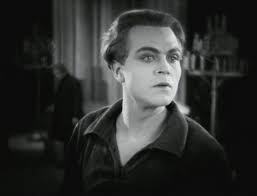



However all of Fritz Lang’s previous work became overshadowed on January 10, 1927 with the release of the now lost 153 minute original cut of “Metropolis”. Two attempts have been made to restore the film. The first in 2002 ran 118 minutes, but more footage was found and the film was once more restored in 2010 to a running time of 148 minutes. Somewhere out there may be the missing five minutes of critical footage to complete Lang’s German expressionist epic science-fiction film.
For the few who may not know the story it tells of a dystopian future Germany under the rule of what is basically a corporation. It then follows the attempts of young Freder part of the elite and the son of the ruler of Metropolis to set things right. As the story progresses he falls in love for Maria a working class girl who also wants to see things changed.
Fritz Lang’s imagery is everywhere in this film. It is not just the futuristic above ground world of luxury of the wealthy elite like young Freder as compared to the dungeon like underground world of the working class like Maria that treats the viewer’s eyes in Lang’s vision, but what is done to Maria that has always caught their attention also.


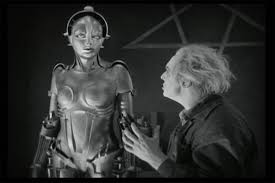

Rudolf Klein-Rogge once more comes through with a powerful performance as a scientist working with the ruler of Metropolis to solidify his power base. The mad genius of a scientist comes up with a plan to make a robot duplicate of Maria to mislead the workers who trust the real girl. The effect of changing the real Maria into her robot double and the look of the robot itself is classic cinema and often viewed by itself.


Eventually the son overturns the power of his father and in a climatic fight on the roof stops as the people of the city look on the evil scientist falls to his doom.

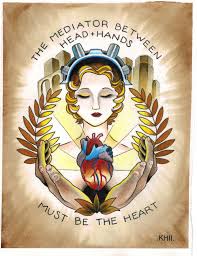
Here are a four behind the scenes looks at the filming of Fritz Lang's masterpiece.
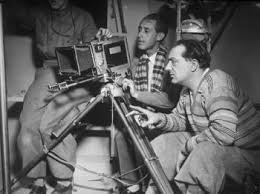
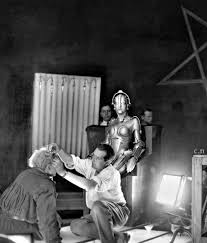
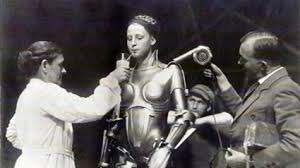
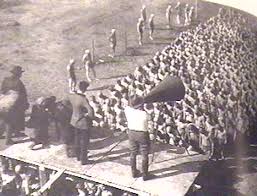
One quick comparison concerns the influence of the Maria Robot on George Lucas which I am sure all my readers are familiar with.


Even more ground breaking for motion pictures, the audience and rocket science was Lang and von Harbou’s 1929 film “Frau im Mond (Women in the Moon) released on October 15th. This was the first scientifically accurate science fiction film ever made. German Rocket Scientist Hernan Oberth one of the top in the world at the time designed the space craft and it was a working model also.
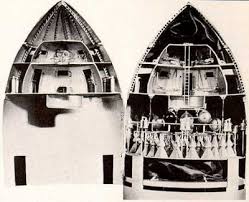


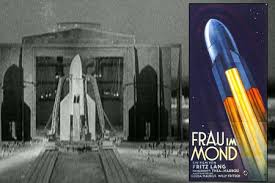
The description of the flight to the moon for its day and actually through the 1950’s is totally accurate and interesting to watch. Compare the scenes below from Fritz Lang's 1929 "Frau im Moon" with George Pal's
1950's "Destination Moon" made 21 years later.

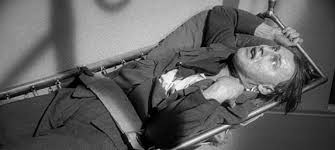
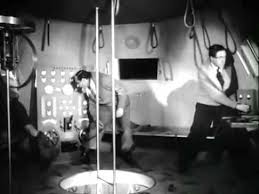
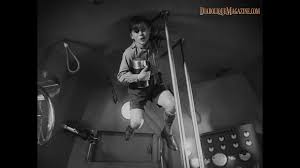

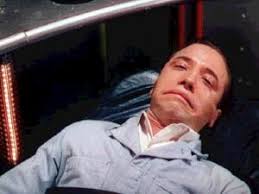
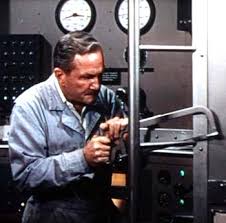

Lang, Harbour and Oberth’s ideas for the moon landscape is very cinematic and works quite well. Again compare them to "Destination Moon".



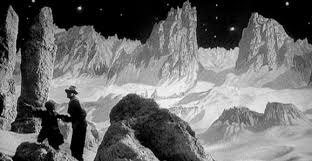




Eventually the son overturns the power of his father and in a climatic fight on the roof stops as the people of the city look on the evil scientist falls to his doom.
Here are a four behind the scenes looks at the filming of Fritz Lang's masterpiece.
One quick comparison concerns the influence of the Maria Robot on George Lucas which I am sure all my readers are familiar with.
Even more ground breaking for motion pictures, the audience and rocket science was Lang and von Harbou’s 1929 film “Frau im Mond (Women in the Moon) released on October 15th. This was the first scientifically accurate science fiction film ever made. German Rocket Scientist Hernan Oberth one of the top in the world at the time designed the space craft and it was a working model also.
The description of the flight to the moon for its day and actually through the 1950’s is totally accurate and interesting to watch. Compare the scenes below from Fritz Lang's 1929 "Frau im Moon" with George Pal's
1950's "Destination Moon" made 21 years later.
Lang, Harbour and Oberth’s ideas for the moon landscape is very cinematic and works quite well. Again compare them to "Destination Moon".
However, it is what Thea von Harbou Lang came up with in 1929 to build tension and suspense in a silent movie for the launch of the space craft that is important to us today. She simply inserted during the scenes of the crew inside the craft and those in the bunker monitoring the launch the numbers 10 through zero in descending order and “The Countdown” was born.
In 1931 Fritz Lang’s first sound film was released and a film he always considered his finest work. The movie introduced a relatively unknown German actor even to that countries movie goers named Peter Lorre. Lorre plays Hans Beckert a child serial killer known only as “M”. A man so repulsive that the German Underworld is tracking him down. Of note is this portrayal would cast Lorre as the villain for years. His big English language break would be in Alfred Hitchcock’s “The Man Who Knew Too Much” from 1934 while Lorre was starting to learn to speak the language.
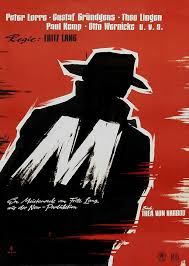
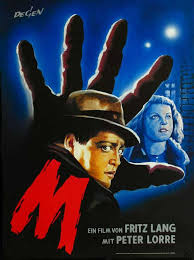
“M” is still powerful today and the scenes in an abandoned distillery were the criminals take child murderer Beckert to face their justice also work even 83 years after they were shot. By their own criminal code even a man as despicable as “M” is entitled to a hearing. The Underworld holds a kangaroo court trial giving Hans Beckert a chance to explain his actions. You find yourself reading every subtitled line of Lorre’s monologue defense of his actions and although, unless you speak German, you have no idea of the actual words being spoken are correctly translated. It is Peter Lorre’s tone and performance that mesmerizes the viewer.


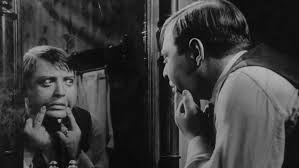
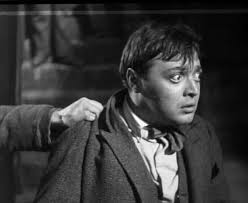
Germany at this time was starting to change as Adolph Hitler and his NAZI Party came to the forefront. It was within this background of changing German politics and racial persecution that Fritz Lang and Thea von Harbou brought back the aforementioned Dr. Mabuse in “Das Testament des Dr. Mabuse (The Testament of Dr. Mabuse).

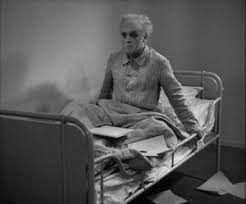


The motion pictures opens with the criminal mastermind an inmate of an insane asylum. Where even in his guarded cell he is working on his criminal plans and somehow they start being implemented. As a sign of the times in the motion picture industry prior to dubbing being used for release in other countries. A second version of the film was shot by Lang for the European Market in French with a French cast released as “Le Testament du Dr. Mabuse” using the same sets.


Germany at this time was starting to change as Adolph Hitler and his NAZI Party came to the forefront. It was within this background of changing German politics and racial persecution that Fritz Lang and Thea von Harbou brought back the aforementioned Dr. Mabuse in “Das Testament des Dr. Mabuse (The Testament of Dr. Mabuse).
The motion pictures opens with the criminal mastermind an inmate of an insane asylum. Where even in his guarded cell he is working on his criminal plans and somehow they start being implemented. As a sign of the times in the motion picture industry prior to dubbing being used for release in other countries. A second version of the film was shot by Lang for the European Market in French with a French cast released as “Le Testament du Dr. Mabuse” using the same sets.
Hitler came to power in January 1933 and on March 14th the new Nazi Ministry of Public Enlightenment and Propaganda was established under Joseph Goebbels. Lang had not finished editing the second “Dr. Mabuse” film and would not have a print for Goebbels to view until March 23rd. After viewing the motion picture Goebbels praised it as the type of film that Hitler wanted for Nazi Germany.Then contrary to that statement informed Fritz Lang that it would still have to be banned under the new rules, because the tone would decrease the audiences confidence in the country's Statesmen and Adolph Hitler himself. Then Goebbels did another about face and informed the filmmaker that because of the style of the motion picture he wanted Lang to work for him. Fritz Lang was offered the head of The German Cinema Institute the highest position in the film industry. He refused and after other filmmakers on Goebbels' list did the same. The position of top German Film Maker would be eventually offered to Leni Riefenstahl a basically unknown who accepted. Her story follows Lang's in this article.
Like his friends Billy Wilder and Peter Lorre the anti-Jewish tone of the Nazi Party bothered Fritz Lang. Thea von Harbou his wife supported the party, but Lang was worried that although he was a practicing Roman Catholic his mother had been Jewish. What could happen if the Nazi’s eventually discovered that fact? Lang and von Harbou would shortly divorce and in June of 1933 he left Germany for France. Some say he left in 1934, but his passport reflects the June 1933 date.
On April 27, 1934 Fox Europa released “Liliom” directed by Fritz Lang. His only movie made in France and starring French Actor Charles Boyer. Interesting this Fox Europa film was produced by Eric Pommer who had also left Nazi Germany. The play “Liliom” was by Hungarian writer Ferenc Molnar, but the story although produced in this country over the years is better known by its musical adaptation. Revised for the Broadway Stage by Rodgers and Hammerstein as “Carousel”.



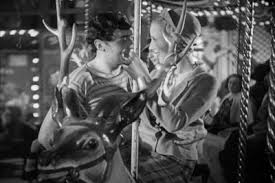
Lang would leave France for the United States and make his first movie here in 1936. The movie was “Fury” and told of an innocent man passing through a small town who is blamed for a girl’s kidnapping. The viewer watches as each time the story is told by one person to another, as in the child’s game of telephone, it keeps getting more distorted until a mob mentality develops. The newly created mob attempt to lynch the innocent man. Playing the accused was Spencer Tracy, but the lead in the film was actress Sylvia Sidney as his girlfriend. Tracy’s Joe Wilson is being protected by the Sheriff in the jailhouse and some of the mob attempt to burn the building down and two members light and throw dynamite causing an explosion. When the dust settles the Sheriff and the townspeople find the body of a dog, but no trace of Wilson. They believe he was literally blown to bits.


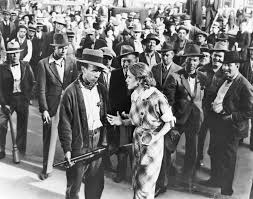

When the District Attorney after discovering Wilson’s innocence attempts to bring those responsible for this crime to justice. The town’s people again band together and refuse to assist him. However, they are confronted with newsreel footage of the bombing. Meanwhile Wilson who was actually freed by the blast and his brothers are seeking revenge on those people responsible for having him put in jail in the first place.


The film is outstanding, but critics complained about how MGM ruined Lang’s original ending by making him add a happy one with included a reconciliation between Tracy’s character and his girlfriend instead of the darker one originally shot. The film was budgeted at $604,000 and made $1,302,000 in 1936 dollars. Fritz Lang and Bartlett Cormack were nominated for an Oscar for the script. The picture and its reviews were a great welcome to Hollywood for Lang.
The film is outstanding, but critics complained about how MGM ruined Lang’s original ending by making him add a happy one with included a reconciliation between Tracy’s character and his girlfriend instead of the darker one originally shot. The film was budgeted at $604,000 and made $1,302,000 in 1936 dollars. Fritz Lang and Bartlett Cormack were nominated for an Oscar for the script. The picture and its reviews were a great welcome to Hollywood for Lang.
Lang would follow “Fury” with another Sylvia Sidney starring vehicle, but instead of Tracy as her co-star it was Henry Fonda with second billing. The released running time of the film, because of the censors was 86 minutes. A full 15 minutes had to be cut from “You Only Live Once”, because of extreme violence. Fonda is an ex-convict who is wrongly convicted of a bank robbery that six people are murdered during. He is sentence to death by electrocution. The film has a hard edge ending where Fonda has a gun smuggled in and is escaping when he accidentally kills the prison chaplain. The chaplain was on his way to tell him he has been pardoned as the body of the real killer and all the bank money has been found in a lake which he apparently drove into. This film went the other way at the box office and lost money. The budget was $628,138 and the box office $589,503.




Lang was combining the Expressionism style of his German films with what he saw of the work from American film makers. He was pioneering what would be known as “film noir” as other filmmakers started to copy his style.
During 1939 Fritz Lang become a naturalized citizen of the United States.
1940 saw Fritz Lang reunited with Henry Fonda in his first stint as a Western director. The movie was “The Return of Frank James” and it picks up the story of Frank after the previous film “Jesse James” directed by Henry King and starring Tyrone Power as Jesse and Fonda as Frank. This film like the first makes Frank James the good guy going after Bob and Charlie Ford for murdering Jesse.

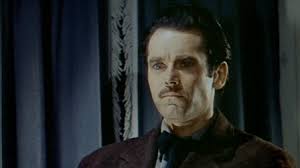
The following year Lang was still in Western mode with “Western Union” based upon the Zane Grey novel and starring Robert Young, Randolph Scott, Dean Jagger and Virginia Gilmore among other things the future Mrs. Yul Bryner in 1944.
The following year Lang was still in Western mode with “Western Union” based upon the Zane Grey novel and starring Robert Young, Randolph Scott, Dean Jagger and Virginia Gilmore among other things the future Mrs. Yul Bryner in 1944.
Even as with his previous crime films Lang was having problems with the Hays Commission’s Censorship on both his Westerns. While his skill as a director and artist was being recognized.
Bosley Crowther of The New York Times considered “Western Union”:
"spectacular screen entertainment" and applauded director Lang's ability to take a "firmly-constructed fiction" and keep it interesting with "plenty of action and colorful incident."
Adding that he considered the film:




one of the finest color films ever seen" and stating that Lang’s use of the Technicolor process produced "breath-taking shots of vast stretches of prairie across which the construction gang is seen drawing its tiny wire
“Man Hunt” starred Walter Pidgeon and Joan Bennett in what would be the first of four anti-Nazi films by Fritz Lang. Based upon Geoffrey Household’s classic thriller “Rogue Male” the story was revised by Dudley Nichols into a screenplay about a British Game Hunter who goes after the biggest game of all Adolph Hitler and the German’s hunt for him. The novel was also the inspiration for David Morrell’s first novel in his 1972 “the Haunted Man series”. Oh that books title: “First Blood” about a Vietnam veteran named Rambo. “Man Hunt” was also the first Hollywood movie for child actor Roddy McDowall who had been evacuated to the United States after the London Blitz by the German Luffwaffe.


1944’s “Ministry of Fear” has Ray Milland in a great World War 2 Spy Film Noir where he is a man just released from a mental asylum. He inadvertently get involved with an international spy ring after he is mistakenly given something they need. The story was from the novel by writer Graham Greene. Greene wrote “The Third Man” which would be made into a 1948 classic with Joseph Cotton looking for Orson Wells’ as Harry Lime.


1948 and 1950 would see two back to back movies were Fritz Lang entered the world of Horror. The first Psychological and the second Gothic.
1944’s “Ministry of Fear” has Ray Milland in a great World War 2 Spy Film Noir where he is a man just released from a mental asylum. He inadvertently get involved with an international spy ring after he is mistakenly given something they need. The story was from the novel by writer Graham Greene. Greene wrote “The Third Man” which would be made into a 1948 classic with Joseph Cotton looking for Orson Wells’ as Harry Lime.
1948 and 1950 would see two back to back movies were Fritz Lang entered the world of Horror. The first Psychological and the second Gothic.
Joan Bennett got top billing over Michael Redgrave in “Secret Beyond the Door” and one might attribute it to her husband Walter Wanger producing it. Although it is Fritz Lang’s name that appears on the film. A somewhat reverse, but typical Hollywood ploy had happened with 1943’s “Moontide”. Lang actually directed the majority of the movie, but Archie Mayo is credited on screen, Novelist John O’Hara was also credited on screen as the writer of that film, but Nunnally Johnson screenwriter for such major films as “The Grapes of Wrath”, “Along Came Jones”, “The Desert Fox: the Story of Rommel” and “The Dirty Dozen” did most of the work uncredited.
“Secret Beyond the Door” is a reworking of the Bluebeard story. Wikipedia has this description for the film:
The behavior of Mark Lamphere, an architect, turns strange shortly after his honeymoon with bride Celia, who begins finding out that Mark has many secrets.
It turns out he was married before, his wife died suspiciously and they have a son. He also has a fiercely loyal secretary, Miss Robey, whose face is disfigured.
Mark appears to be somewhat delusional and could be intending to murder Celia inside a room he keeps locked. The disturbed Miss Robey ends up setting fire to the house, whereupon Mark redeems himself by saving Celia's life.
The film was a major bomb with a screenplay by Silvia Richards that plays like a Sigmund Freud dream gone wrong. The script in some areas is a direct rip off of the 1940 movie “Rebecca”.
IMDb described “House by the River” considered a Gothic Film Noir as:
The unsuccessful writer Stephen Byrne tries to force his servant Emily Gaunt sexually while his wife Marjorie Byrne is visiting a friend and accidentally strangles her. His crippled brother John Byrne coincidently comes to his house in that moment, and Stephen asks him to help to get rid of the corpse and avoid a scandal, since his wife would be pregnant. The naive and good John helps his brother to dump the body in the river nearby his house. Stephen uses the disappearance of Emily to blame her and promote his book. When the body is found by the police, all the evidences points to John, and he becomes the prime suspect of the murder.
Fritz Lang wanted the part of Emily Grant to be played by a black actress, but both the producer Howard Welsch and Republic Pictures would have nothing to do with that idea. This was 1950 and they used the possible loss of bookings in the South as their main excuse.
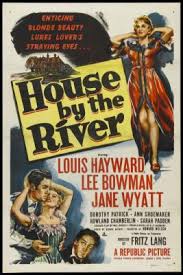



When the film came out it was panned by critics, but Tom Vick in his 2013 release “All Movie Guide by Rovi” wrote:
Lang beautifully evokes the Victorian era with his customary attention to detail. Cinematographer Edward J. Cronjager's low-key lighting fills the Byrnes mansion with appropriately gloomy shadows, and the moonlit river scenes make it seem as if nature itself is offended by the crime. Avant-garde composer George Antheil's haunting score is the perfect accompaniment to this chilling and unconventional exercise in suspense.
We now come to the ups and downs of “American Guerrilla in the Philippines” starring Tyrone Power and Tom Ewell. The movie is based upon the book by War Correspondent Ira Wolfert about the experiences of Navy Ensign Ilifff David Richardson whose PT boat was sunk. Richardson along with the crew became Guerrilla fighters in the Japanese controlled Philippines. The U.S. Army temporary transferred Richardson to their command during this time and he held the rank of Major.


Darryl F. Zanuck bought the rights to the book in 1945 when it came out from Ira Wolfert. The plan was to immediately make a movie. The original cast was to have been Fred MacMurray in the fictional role of Ensign Chuck Palmer and William Bendix as Jim Mitchell and shot in Puerto Rico by director Henry King. This was shelved and the film was recast with John Payne as Palmer and instead of the Mitchell character a female lead played by Linda Darnell was added and the plan was to film on Catalina Island. However, World War 2 ended and Zanuck stopped all World War 2 film production.
Move to 1950, the Korean War, and the return of the film project. Enter Tyrone Power as Palmer and Tom Ewell as Mitchell with Fritz Lang as director. This time the film would be shot in color and in the Philippine Islands with Philippine extras. The film premiered in the Philippines to excellent box office and critical praise. However, there was a protest by Filipino actors as not one Filipino name were in the credits. Zanuck would have the credits redone for all further releases giving the main Filipino actors appearance credit. This is Lang’s least favorite film of his career.
On May 23, 1952 RKO Pictures released one of my all-time favorite off beat Westerns Fritz Lang’s “Rancho Notorious” starring Marlene Dietrich, Arthur Kennedy and Mel Ferrer. This is the story of a criminal hideout called “Chuck-a-Luck” run by Dietrich and two men who become fast friends until one of them discovers it is the other they are out for revenge against over the death of his fiancee.


The original title for the film was “The Legend of Chuck-a-Luck” which the owner of RKO Pictures Howard Hughes disliked and changed to “Rancho Notorious”. At least he allowed the catchy story song to be left within the film as a means of scene change.
The critics including “Variety” didn't really like it. According to “Variety”:
This Marlene Dietrich western has some of the flavor of the old outdoor classics (like the actress's own onetime Destry Rides Again) without fully capturing their quality and magic. The characters play the corny plot [original story by Silvia Richards] straight; directing keeps the pace lively and interesting, and the outdoor shots, abetted by the constant splash of color, are eye-arresting. Dietrich is as sultry and alluring as ever...Dietrich is a dazzling recreation of the old time saloon mistress, and handles her song, 'Get Away, Young Man', with her usual throaty skill.
It’s that “corny plot” that I actually enjoy and the way the three leads play things straight. One also has to remember the picture came from the Howard Hughes Era at RKO. Where we also saw the Western “The Outlaw” where Hughes had his Trans World Airline structural engineers design a more uplifting bra for Jane Russell and John Wayne played Genghis Khan.
From a major play by Clifford Odets the 1952 film “Clash By Night” starred Barbara Stanwyck, Paul Douglas and Robert Ryan, but it was the fourth billed lead Marilyn Monroe that would make the news. During the filming of this semi-film noir a now famous calendar came out featuring her first nude shoot. Fritz Lang and the cast were having major problems with the news media who wanted to interview Monroe. This was also the first real problems for Marilyn dealing with the sudden publicity and not knowing how to mentally handle what she had created. The movie was a money maker and how much was due to Monroe’s calendar is unknown.


According to Wikipedia:
Critic Sam Adams wrote about Fritz Lang's directorial style, "Restraint was never Fritz Lang's problem. Indeed, his version of Clifford Odets' Clash by Night is overwrought verging on camp... In Clash's wild kingdom, strong women can only be sated by the threat of male violence: After she marries sturdy lug Paul Douglas, Stanwyck is unerringly drawn towards Ryan's volatile woman-hater, while fish-canner Marilyn Monroe shows her affection to fiancé Keith Andes by socking him in the arm, a gesture he threatens to return in spades. Lang tilled the same turf two years later in Human Desire, a similarly heavy-handed expose of man's bestial nature. Perhaps Lang should have stuck with the style of Clash's extraordinary, near-wordless opening, which begins with shots of seagulls and seals and slowly mixes in the actors in their natural habitats.
Fritz Lang next made in 1953 “The Blue Gardenia” the first of what would be called his “Newspaper Noir” trilogy. The second film “While the City Sleeps” and the final entry “Beyond a Reasonable Doubt” were both made and released in 1956. The films are connected not with cast, but as they revolve around newspapers and reporters being caught up in crime stories.



The non-screenplay importance of these three films is that “The Blue Gardenia” starts the last three years of making motion pictures in the United States for Fritz Lang and “Beyond a Reasonable Doubt” ends it. This was also the period when the director started to go blind.
The non-screenplay importance of these three films is that “The Blue Gardenia” starts the last three years of making motion pictures in the United States for Fritz Lang and “Beyond a Reasonable Doubt” ends it. This was also the period when the director started to go blind.
Between these films was 1953’s “The Big Heat” considered the last major work made by Lang in the United States! The film stars Glenn Ford, Gloria Grahame and Lee Marvin. The film noir is about Homicide detective Sergeant Dave Bannion played by Glenn Ford. He takes on the crime syndicate led by Mike Lagana that controls his city after they kill his wife. Bannion resigns from the force and becomes a vigilante and goes after Lagana’s second in command Vince Stone played by Lee Marvin. Gloria Grahame plays Debbie Marsh the girlfriend of Stone, but starts to fall for Bannion.
The film is best known for the scene in which Marvin’s Stone makes the mistake of disfiguring the face of Grahame turning her into the means of bringing him and his boss down. The film was well received by the film critics even though some thought Ford’s character is also really not likable to be someone the audience should identify with.


As critic Grant Tracey wrote:
As critic Grant Tracey wrote:
Whereas many noirs contain the tradition of the femme-fatale, the deadly spiderwoman who destroys her man and his family and career, The Big Heat inverts this narrative paradigm, making Ford [Det. Bannion] the indirect agent of fatal destruction. All four women he meets—from clip joint singer, Lucy Chapman, to gun moll Debby—are destroyed.
I have seen the film several times and always enjoy the interplay between the three leads. As it is a character drawn film.
With the exception of the Newspaper Trilogy during this period the two other films Fritz Lang made before he left the United States for Germany in 1959 are truly forgettable. As I mentioned previously Lang was losing his sight and now wore an eye patch over his right eye looking like a pirate captain which apparently he joked about.
In 1959 Lang directed the first of two German-French-Italian films which became “Fritz Lang’s Indian Epic” about a German architect in India. The first film was “Der Tiger Von Eschnapur (The Tiger of Eschnapur)” and starred American Actress Debra Paget and German Actor Paul Hubschmid. Hubschmid used a more non-German name when he made films in Hollywood. My readers who are into Science Fiction and Stop Motion Animation know Hubschmid under his American acting name of Paul Christian from Ray Harryhausen’s 1953 classic “The Beast from 20,000 Fathoms” as the two following pictures show.

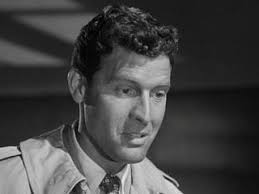
The first film has architect Harold Berger, Hubschmid, arriving in India to build for a Maharaja. While there he saves a young dancer, Paget, from a tiger. The two fall in love, but she is promised to the Maharaja. The film ends as a cliffhanger with the two fleeing into the desert from the Maharaja as he decides now to build a tomb and will use Berger’s brother as the builder.




The first film has architect Harold Berger, Hubschmid, arriving in India to build for a Maharaja. While there he saves a young dancer, Paget, from a tiger. The two fall in love, but she is promised to the Maharaja. The film ends as a cliffhanger with the two fleeing into the desert from the Maharaja as he decides now to build a tomb and will use Berger’s brother as the builder.
The second film also in 1959 “Das indische Grabmal (The Indian Tomb)” picks up the story as the Maharaja continues to build his tomb and settles the love story of the Berger and Dancer characters.

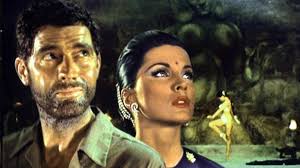


The original film version of these stories was a single three and a half hour silent film made in 1921 based upon a novel by Lang’s wife Thea von Harbou. Fritz Lang did not direct. When he made his version Lang divided the story into two films of about 100 minutes each.
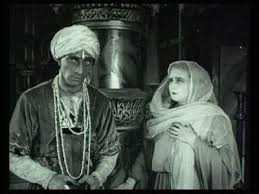

James H. Nicholson at American International Pictures acquired the rights to the two films. AIP proceeded to edit them into one film running 95 minutes. The title of the film depending on where they showed it was either “Journey to the Lost City”, or “Tiger of Bengal”. AIP once more billed Paul Hubschmid as Paul Christian. The Hayes Office also got into the act and Debra Paget’s dance was heavily edited. You can find the dance on You Tube as originally filmed.
Lang’s original cut of the two films was thought lost, but a copy of both were discovered and released on two separate DVD’s with both a German and English language track by Image Entertainment in 2001.
As mentioned earlier in 1960 the last film in Lang’s Dr. Mabuse Trilogy was made. “Die 1000 Augen des Dr. Mabuse (The Thousand Eyes of Dr. Mabuse) starred Peter van Eyck in the title role and Gert Frobe four years before he would play “Goldfinger” as the Police Inspector after him. However, it was British Actress Dawn Adams who had top billing. The film was not up to the quality of Lang’s previous two, but spawned the series of films I also mentioned before.
Lang would appear in a cameo as himself in French director Jean-Luc Godard’s “Contempt” in 1963. After which Fritz Lang disappeared from the motion picture industry and most movie goer’s knowledge. On television “Western Union” and “Rancho Notorious” would show up from time to time and even “The Big Heat”, but unless you were a Foreign film buff going to an Art House movie theater to see a bad prints of “Metropolis” and “M”, or one of his two earlier Mabuse film’s the name of Fritz Lang means nothing to the average American movie goer.
Sometime after the Godard film Fritz Lang’s friendship with actress Lily Latte whom he had directed back in 1934 France in “Liliom” apparently became more than that. The two were married in 1971 and that would last until his death in 1976. Lang is buried in the Forest Lawn-Hollywood Hills Cemetery in Los Angeles.
Fritz Lang’s American period of film making is ignored by most Cinema historians and film critics and passed off as nothing more than a few war era movies, spy films and thrillers. His champions are found in Europe and especially France with such film makers as Francois Truffaut and Jacques Rivette.


One does not know their future at birth and it can still haunt you at 101 years of age on your death bed.
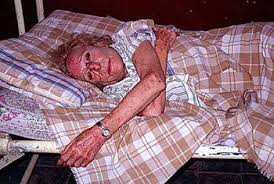
In 1933 Joseph Goebbels offered Fritz Lang the position of head of “The German Film Institute” which would have made Lang the most powerful film maker in the country, but it also meant Fritz Lang would be working hand and hand within the policies of the Nazi Party and mandated to join the party. Lang’s answer was “no”! Shortly after the offer he left Germany and would not return for another 26 years.
Goebbels needed a film maker to head the institute and was turned down by other filmmakers he approached. One reason was the German film industry was predominately Jewish in the director and producer areas. Eventually Joseph Goebbels made the same offer to 31 year old Leni Riefenstahl and she accepted.

Her decision to work for the Nazi Party and make two specific films at the request of Adolph Hitler, become part of a controversy that lasted for the rest of Riefenstahl's life. This is her story and you decide how you view that life and those two infamous, or famous films “Victory of Faith” and “Triumph of the Will”.
Her decision to work for the Nazi Party and make two specific films at the request of Adolph Hitler, become part of a controversy that lasted for the rest of Riefenstahl's life. This is her story and you decide how you view that life and those two infamous, or famous films “Victory of Faith” and “Triumph of the Will”.
THE DANCER
Helene “Leni” Bertha Amalie Riefenstahl was born on August 22, 1902 in Berlin, Germany to a very prosperous German Protestant family.

Her father Alfred Riefenstahl was the owner of a major heating and ventilation company and he wanted his daughter to follow in the family business. Her mother Bertha Scherlach Riefenstahl had dreams of her own for Helene and believed her beautiful girl should go into show business making an interesting dynamic within the household.
Helene had a younger brother Heinz, He would die on the Russian Front during World War 2 at the age of 36 fighting for Hitler’s Germany.
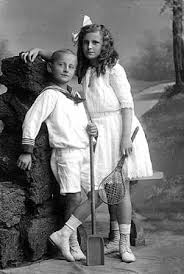
Ten year old Leni and Seven year old Heinz
While her father saw Helene as the heir to his business. Her mother started realizing where “Leni’s” talent lay, When at the age of 4 she started to not only paint, but write very good poetry. At the age of 12 Leni joined a gymnastic and swim club adding both of those disciplines to her painting and poetry writing. Her father stayed disappointed and refused to support his daughter. He felt strongly that she should be thinking of a real profession, even at this young age, that would support her through the realities of life. Art, poetry, gymnastics and swimming to Leni's father were fine, but as hobbies.
That interesting dynamic in the household kept showing itself. Leni's mother still saw the girl's future differently from her husband. So at the age of 16 she took Leni to a dance performance of “Snow White”. It was this performance that brought the young girl to the decision that her future was tied to dance, but once more she ran afoul of her father. He was willing only to pay for her education in a field that would lead Leni to a solid business life. Her father would not waste his hard earned money on dance, or art lessons. However her mother rebelled and enrolled the girl in dance and ballet classes at the Grimm-Reiter Dance School in Berlin.
Her father Alfred Riefenstahl was the owner of a major heating and ventilation company and he wanted his daughter to follow in the family business. Her mother Bertha Scherlach Riefenstahl had dreams of her own for Helene and believed her beautiful girl should go into show business making an interesting dynamic within the household.
Helene had a younger brother Heinz, He would die on the Russian Front during World War 2 at the age of 36 fighting for Hitler’s Germany.
Ten year old Leni and Seven year old Heinz
While her father saw Helene as the heir to his business. Her mother started realizing where “Leni’s” talent lay, When at the age of 4 she started to not only paint, but write very good poetry. At the age of 12 Leni joined a gymnastic and swim club adding both of those disciplines to her painting and poetry writing. Her father stayed disappointed and refused to support his daughter. He felt strongly that she should be thinking of a real profession, even at this young age, that would support her through the realities of life. Art, poetry, gymnastics and swimming to Leni's father were fine, but as hobbies.
That interesting dynamic in the household kept showing itself. Leni's mother still saw the girl's future differently from her husband. So at the age of 16 she took Leni to a dance performance of “Snow White”. It was this performance that brought the young girl to the decision that her future was tied to dance, but once more she ran afoul of her father. He was willing only to pay for her education in a field that would lead Leni to a solid business life. Her father would not waste his hard earned money on dance, or art lessons. However her mother rebelled and enrolled the girl in dance and ballet classes at the Grimm-Reiter Dance School in Berlin.
Another article says Leni's age at this time was 15 which really is not important, Her father found out about the classes and threatened his wife with divorce, if she let the girl continue. A compromise was worked out, or so Leni’s father thought. She would be enrolled in the Crown Prince Palace academy to learn drawing and painting. What her father did not know was that Leni was still attempting to learn dance on her own with her mother’s full knowledge and cooperation.
It would take the girl until the age of 19 to finally convince her father that dancing was his daughter's life and career. It was arranged for Leni to study ballet with the Russian prima ballerina Eduardova. Being so far behind she doubled her work load and studied modern dancing with Mary Wigman and Jutta Klamt. At the age of 21 Helene “Leni” Bertha Amalie Riefenstahl gave her first performance in the Berlin Bluthner Hall and became famous in Germany overnight as a result.
Leni Riefenstahl was “Discovered” by Max Reinhardt who was the director of various theaters and managed the Deutsches Theater (“German Theater”) in Berlin and the Theater in der Josefstadt in Vienna.
Leni was the first dancer to ever perform alone on stage at the prestigious Deustsches Theater and this occurred every night for a complete week. She then went on tour giving over 70 performances under the direction of Reinhardt. However, during a split jump in a theater in Prague she injured her knee so severely that her dancing career was over. Almost as fast as it actually started after all that hard work, training and battles with her father.
Leni was the first dancer to ever perform alone on stage at the prestigious Deustsches Theater and this occurred every night for a complete week. She then went on tour giving over 70 performances under the direction of Reinhardt. However, during a split jump in a theater in Prague she injured her knee so severely that her dancing career was over. Almost as fast as it actually started after all that hard work, training and battles with her father.
I should point out for what is to come in Leni Riefenstahl’s life that Max Reinhardt was in reality Austrian Jew Maximilian Goldman, using a more German sounding name to be acceptable. Along with the likes of Fritz Lang and Peter Lorre he would flee Germany in 1933.
The question should be asked even if one speculate about what Leni’s future life would have been, if that accident never occurred and she continued under the mentoring of Reinhart in dance and enrolled in his acting school in Vienna considered the premiere in Europe?
The question should be asked even if one speculate about what Leni’s future life would have been, if that accident never occurred and she continued under the mentoring of Reinhart in dance and enrolled in his acting school in Vienna considered the premiere in Europe?
THE ACTRESS
Leni Riefenstahl stated that in 1924 she went to the movies and saw a film by producer Arnold Fanck called “Berg des Schicksals (Mountain of Destiny)”. The silent film was about an "Alpinist" who falls to his death while climbing a dangerous peak. Riefenstahl decided to contact Fanck about being an actress in one of his movies and this would lead to her acting career and the next step in her convoluted life.
The first appearance of Leni Riefenstahl on film was as a dancer in a small scene in the 1925 silent “Wege zu Kraft und Schonhelf (Way to Strength and Beauty”). The film was about health and beauty in conformity with nature directed by Nicholas Kaufmann and actually starred American Boxer Jack Dempsey. The film featured future MGM movie Tarzan Johnny Weissmuller who had just become an Olympic Swimming Champion at the 1924 Games.
The first film by Arnold Fanck Leni Riefenstahl would act in was “Der heillge Berg (The Holy Mountain)”. As with the previous movie she played a dancer and in the script falls in love with an engineer at his cottage in the mountains. The film actually began production prior to “Way to Strength and Beauty” in January of 1925, but weather conditions in the Alps prevented it from being completed and the film would not be released until 1926. Riefenstahl would continue to appear in films by Franck playing the athletic lead and projected solid sexuality on the silent screen in these roles while becoming very popular with the German public.
Leni accompanied Arnold Fanck to the 1928 Winter Olympic Games in St. Moritz, Switzerland. These were the first true Winter Games held separately for the first time. It was during the games the Rienfensthal became interested in athletic photography and attempted filming them.
In 1930 Erich Pommer at UFA studios considered her for the role of Lola-Lola in a film he was producing to be directed by Josef von Sternberg. Leni Riefenstahl lost the part to her next door neighbor Marlene Dietrich. The film was “The Blue Angel” and made Dietrich an international star. Once more one has to wonder if fate had not intervened would Leni not Dietrich played the part of “Frenchy” opposite James Stewart in 1939’s “Destry Rides Again” and off to becoming an important star in the United States instead of making films for Nazi Germany?
After two more films as an actress and under the mentoring of Arnold Fanck who was teaching her the skills of directing. In 1932 Leni Riefenstahl made her first directorial debut in “Das blaue Licht (The Blue Light)” a film in which she also starred, co-produced and co-wrote. In the film Riefenstahl plays Junta a young women who lives alone on a mountain near a alpine village where several young men have felt compelled to climb and all have fallen to their death. The villagers believe she is a witch.
The movie was one of the first sound era motion pictures filmed entirely on location which was a feat in itself in those early days of talkies. The movie opened in Germany on March 24, 1932 and in the United States on May 8, 1934. The following are some descriptions of Riefenstahl’s first directorial work by American newspapers from a Wikipedia article on the film:
“The New York Sun described the film as "one of the most pictorially beautiful films of the year. Leni Riefenstahl - author, director and star - is an expert climber as well as handsome woman."
The New York Herald Tribune praised the "sheer pictorial beauty", the publication also praised Riefenstahl remarking "how flawlessly this girl, who plays the lead and also wrote and directed, accomplished her task."
The New York Herald Tribune praised the "sheer pictorial beauty", the publication also praised Riefenstahl remarking "how flawlessly this girl, who plays the lead and also wrote and directed, accomplished her task."
The New York Times remarked that "a summary of the story gives no adequate idea of the beauty of the action and the remarkable camera work, especially in connection with the light effects."
The film won the “Silver Medal” at the “Venice Biennale” a major bi-annually art competition in Venice, Italy. However, the film was not well received outside of Germany and Leni Rienfenstahl blamed the critics for this and noted that they were prominently Jewish. When the film was re-released in 1938 she had the names of her co-writers Bela Balazs and Harry Sokai removed because they were also Jewish. You could argue that in 1938 she was now working under Nazi Germany, but Rienfenstahl is on record as turning over the names of her co-screen writer’s earlier to Nazi Propagandist Julius Streicher. Whose newspaper “Der Sturmer” was a central element in Nazi propaganda and would publish three anti-Semitic books for school children.
Prior to the release of “Blue Light” in the United States Leni Rienfenstahl had received offers to come to Hollywood and make films in this country, but supposedly she turned these offers down to stay with a boyfriend. One of those who considered himself a patron of the arts and found “Blue Light” an outstanding example of German film making and wanted to meet its director was Adolph Hitler the head of the Nazi Party who became the German Chancellor in 1933.
FILMING FOR THE NAZI PARTY
Question:
What did Leni Riefenstahl think of the Chancellor Adolph Hitler?
What did Leni Riefenstahl think of the Chancellor Adolph Hitler?
In her autobiography “Leni Riefenstahl – A Memoir” St. Martin’s Press, 1993 she writes of hearing him speak at a really in 1932:
"I had an almost apocalyptic vision that I was never able to forget. It seemed as if the Earth's surface were spreading out in front of me, like a hemisphere that suddenly splits apart in the middle, spewing out an enormous jet of water, so powerful that it touched the sky and shook the earth"
According to the German newspaper “The Daily Express” for April 24, 1934 Riefenstahl stated having read Hitler’s “Mein Kampf” while making “The Blue Light”:
"The book made a tremendous impression on me. I became a confirmed National Socialist after reading the first page. I felt a man who could write such a book would undoubtedly lead Germany. I felt very happy that such a man had come"
In 1933 Leni wrote Hitler a letter asking to meet him and he granted her request. From that meeting she received his permission to film the 1933 fifth Nazi Party rally which was to be held at Nuremberg starting on the last day of August. The result was “Der Seig des Glaubens (Victory of Faith) an hour long propaganda film promoting National Socialism and had a sequence with Hitler and Ernst Rohm which gave it major historical significance to students of Nazi Germany.
Ernst Rohm was a German officer in the Bavarian Army and an early Nazi Party leader. He was also the co-founder of the Sturmabteilung (Storm Battalion, the S.A.) and he was murdered during “Nacht der langen Messer (The Night of the Long Knives)” in July 1934. Although Heinrich Himmler oversaw the murder plot this was Hitler removing a strongly liked potential rival. Sometimes referred to as “Operation Hummingbird, but more commonly in Germany as the “Rohm-Putsch (Rohm Purge), because it not only removed Rohm but all his known allies. Adolph Hitler was consolidating his power base. After the purge was completed Hitler ordered all copies “Der Seig des Glaubens” destroyed, but one turned up 57 years later in the UK confirming the relationship between the two leaders at the start of the Nazi Party’s rule of Germany and the idea of a joint leadership.
As I wrote also in 1933 Fritz Lang was offered, but turned down the position of head of “The German Film Institute” as it involved becoming a member of the Nazi Party and Joseph Goebbels eventually offered it to Leni Riefenstahl and she accepted.
Why the position was offered to this 31 year old young women who had only acted in 8 motion pictures, directed “The Blue Light” and now one short propaganda film is a good question. There were many more experienced motion pictures directors in the industry still remaining in the country. By accepting Goebbel’s offer Riefenstahl overnight became the most powerful film maker in Germany. Was it the apparent requirement to join the Nazi Party that made other film makers like Lang refuse? Although some did join on their own. Where others offered the position and finally Goebbel’s got to Leni? We know that Riefenstahl always claimed she never was a party member.
It does appear that her mentor Arnold Fanck was offered the position before her also and this quotation from his biography on Wikipedia gives us perhaps an answer, or again doubt of her words.
According to Wikipedia:
“During the National Socialist period, Fanck got in trouble with propaganda minister Joseph Goebbels, since he refused to cooperate — apparently because of the necessity of joining the party. In 1934, he also began working on his film, Der ewige Traum/Der König vom Mont-Blanc, which not only starred a French hero in French mountains, but also had a Jewish producer, Gregor Rabinowitsch. This conflict brought Fanck into economic difficulties, from which he was only able to escape by accepting a contract from the Japanese ministry of culture in 1936.”
If Fanck, like Lang, refused Goebbels over “the necessity of joining the party”. How could Leni have accepted the position without becoming a Nazi Party Member? We know from “The Daily Express” article that she “became a confirmed National Socialist--“from just reading the first page of “Mein Kampf” of course that story could be false and again I leave the answer up to my reader.
TRIUMPH OF THE WILL
“On 5 September 1934.
20 Years after the outbreak of the World War,
16 years after the beginning of German suffering,
19 months after the beginning of the German rebirth.
Adolf Hitler flew again to Nuremberg to review the columns of his faithful followers.”
Opening dialogue to “Triumph of the Will” written by Riefenstahl.
20 Years after the outbreak of the World War,
16 years after the beginning of German suffering,
19 months after the beginning of the German rebirth.
Adolf Hitler flew again to Nuremberg to review the columns of his faithful followers.”
Opening dialogue to “Triumph of the Will” written by Riefenstahl.
The only source we have for conversations between Leni Riefenstahl and Adolph Hitler about the making of “Triumph of the Will” is her own memoirs. So again you the reader have to make a decision on how you weigh her words.
According to Riefenstahl Hitler was very impressed with the work she did with “Der Seig des Glaubens” and wanted her to film the upcoming 1934 Party rally again in Nuremberg. According to Leni she told him “no”, because:
"I would not be able to go on living if I had to give up acting".
How filming the picture would stop her from acting was never explained by Riefenstahl. Her statement becomes even more confusing as the memoir further states Leni wanted to return to making feature films and specially wanted to film Adolph Hitler’s favorite opera by Eugen d’Albert’s called “Tiefland (Lowlands)”.
The opera is still a favorite in Germany and Austria. According to Leni Riefenstahl she received private funding, the source is never mentioned, and went to Spain to shoot the film, but problems developed which stopped production. So she returned to Germany and agreed to film the sixth Nazi Party rally for Hitler and it would be another six years before she would work on the film Opera film once more.
Filmed in 1934 and released in 1935 “Triumph des Willens (Triumph of the Will)” the title came from Hitler and would become an epic piece of propaganda. Given unlimited funds and resources Leni Riefensthal would produce, direct, edit and co-write the dialogue for her film treatment of the 1934 Nazi Party rally. The “Congress”, as the rally was called, reflected the strength and power of Hitler as it was attended by an estimated 700,000, or more Nazi supporters and Riefenstahl’s lenses would intimately capture the moment for the World to see.
The 114 minute film contains parts of speeches given by Hitler, Rudolf Hess, Julius Streicher and other Nazi party leaders interspersed with footage of massed Sturmabteilung (S.A.) and Schutzstaffel (S.S.) troops out among the German public. The message delivered by Leni Riefenstahl to the German people and the World audience was that Germany was now a great power and Adolph Hitler the leader who had brought this to his nation.
Looking at this movie today “Triumph of the Will” has an interesting duality to it.
To begin with there is no question that the motion picture is one of the greatest filmed works of propaganda ever made. Leni Riefenstahl’s choice of scenes and her editing combined to make it so and it is today still recognized as such and her model still used.
The flipside of this duality is her film work itself. Leni Riefensthal created techniques and developed others beyond their current use. These techniques included moving cameras, aerial photography, the use of long focus lenses to purposely create a distorted perspective to certain scenes and the revolutionary approach with her use of music tied to the imagery to create a specific reaction from the audience. The film would win awards in Germany, France, Sweden and other countries including at the time the United States. However, what is also noted is that many of the scenes were set up and rehearsed by Riefenstahl as many as 50 times to get just what she wanted on the screen.
Looking at that duality in its entirety. Director Leni Riefenstahl’s “Triumph of the Will” influenced American director Frank Capra’s “Why We Fight” World War 2 series of American propaganda which copied her style. Raising the question why condemn Riefenstahl and not Capra?
THE CONTROVERSY OF THE FILM AS REFLECTED BY BOTH LENI RIEFENSTAHL AND MOVIE CRITIC ROGER EBERT
According to Riefenstahl, who was an active participant at the 1934 rally not just as a filmmaker. She made the film without having any knowledge of Hitler’s genocidal or anti-semitic policies. She also kept pointing out to her distractors that her film contains “not one single anti-semitic word”. Although there is a scene of Julius Streicher prominently stating “a people that does not protect its racial purity will perish”. Do we argue semantics with her?
Roger Ebert made this observation on June 24, 1994 concerning her statements. Ebert made the point that:
“the very absence of anti-semitism in Triumph of the Will looks like a calculation; excluding the central motif of almost all of Hitler’s public speeches must have been a deliberate decision to make the film more efficient as propaganda.”
Consider that Riefenstahl admitted all the speeches were edited in the film.
Leni Riefenstahl repeatedly to the day she died defended herself against the charge that she was a Nazi propagandist with the film saying in 1964:
“If you see this film again today you ascertain that it doesn't contain a single reconstructed scene. Everything in it is true. And it contains no tendentious commentary at all. It is history. A pure historical film... it is film-vérité. It reflects the truth that was then in 1934, history. It is therefore a documentary. Not a propaganda film. Oh! I know very well what propaganda is. That consists of recreating events in order to illustrate a thesis, or, in the face of certain events, to let one thing go in order to accentuate another. I found myself, me, at the heart of an event which was the reality of a certain time and a certain place. My film is composed of what stemmed from that” and this one line statement: "I just observed and tried to film it well. The idea that I helped to plan it is downright absurd."
The obvious problem here is the line “it doesn’t contain a single reconstructed scene.” When we know she staged and rehearsed sequences as many as 50 times according to records even made by her and other people involved in 1934. In fact is this issue is still debated, because if staged how would the film be able to be classified as a “documentary” as Riefenstahl claimed? She even claimed you could not call the film propaganda as there is no voice over narration. How that fact negates the construction of the work makes no sense, but apparently this was one of Leni’s main defenses.
Ebert also stated that the film is:
"by general consent one of the best documentaries ever made", but he added that the subject matter is about one of the most evil movements in the world at the time.
Roger Ebert than posed a question of how far a film maker should go saying that Triumph of the Will to him:
“is a classic question of the contest between art and morality: Is there such a thing as pure art, or does all art make a political statement?"
“is a classic question of the contest between art and morality: Is there such a thing as pure art, or does all art make a political statement?"
Therein lies part of the controversy and the questions about the real origins of the film and Leni Riefenstahl perhaps.
OLYMPIA PARTS ONE AND TWO
One year after the release of “Triumph des Willens” Germany was the site of the 1936 Olympic Games and Leni Riefenstahl would film them and take almost two years to edit “Olympia” released in 1938.
The 1936 Summer Olympic Games under Adolph Hitler’s Nazi Germany seems a strange twist of fate, but Germany had bid for the games and been awarded them in 1931 two years before he came to power. Now Hitler was faced with not only the World watching Germany, but the problem of Nazi racial policy at the games which would be highlighted by Black American Jesse Owens.
Hitler initially saw the games as a means of promoting his government’s ideals of Aryan supremacy which meant to him racial superiority. The official Nazi Party newspaper the Volkischer Beobachter wrote in the strongest terms that Jews and Black people should not be allowed to participate in the games as they diluted the purity of the Greek Ideals which founded them.
Almost every other country that was to participate threatened to boycott the Berlin Olympics and Hitler had to change his strategy. He would permit Jews and Blacks to participate in the games and to show that he was not a racist. Hitler personally requested a German woman now living in the United States and attending USC, 26 year old Helene Mayer, to be added to the German Team.
Her father was Jewish and had died in 1931. Mayer’s mother was Lutheran and she never considered herself to be Jewish. Technically under Jewish Law it is your mother that determines this and not your father. Had her mother been Jewish and her father Lutheran than Mayer would definitely be Jewish no matter what she claimed.
Helene Mayer accepted Hitler’s offer, because she thought this was a way to be accepted back into German Society. She was mistaken as Adolph Hitler thought of her as nothing more than a Token Jew and new she didn’t consider herself one. Prior to her family leaving Germany she had won 6 German Championships and came in fifth at the 1932 Games in Los Angeles. Mayer would win the Silver Medal for Women’s Fencing in 1936 and cause further controversy by wearing a swastika and extending her right arm in a Nazi salute. The naïve Mayer disappointed at not becoming a German citizen would return to the United States and between 1937 and 1946 win the U.S. Women’s Foil Championship seven times.
The original request for the film, according to Riefenstahl, was made by the International Olympic Committee which has no record of making such a request. As Nazi Germany was funding the Olympics and the film. Hitler figured it would be another propaganda piece by Riefenstahl that he could use.
Once edited this monumental motion picture documentary, with an unbelievable 250 miles of film shot, was the first ever motion picture of any Olympic games and was edited personally by Leni into two parts. The first part runs 126 minutes and is entitled “Olympia 1. Teil – Fest der Volker (Festival of Nations)” and the second part runs 100 minutes and was entitled “Olympia 2. Teil – Fest der Schonheit (Festival of Beauty)”. The film is listed in “Time Magazines All-Time 100 Greatest Movies”.
Once more Leni Riefenstahl pioneered movie techniques that are commonly used today. One such was the first use of motion picture cameras on rails for tracking shots. She also utilized slow motion shots of some of the athlete’s for the first time to dramatize their performance.
The 1936 Summer Olympics was the inaugural of the Torch run from Athens to the city of the Games. Riefenstahl traveled to Greece to film its start and followed the torch’s path from there into Berlin and the first ever lighting of the Olympic flame at the modern games in this way. There is no question Leni Riefenstahl was an artist with the motion picture camera and “Olympia” Parts One and Two shows this as did “Triumph of the Will” in its way.
Riefenstahl made three versions of the film and each is slightly different in her editing to fit the countries it was to be seen within. One version is German, one French and one English. As pointed out by many the famous diving sequence consider the penultimate sequence of the entire film ran originally 4 minutes in length, but is some versions is only 50 seconds. There were few screenings of the film in English speaking countries after it premier on April 20, 1938 in honor of Hitler’s 49th birthday. Leni would agree to cut out three minutes from footage of Hitler in 1955 so her two part documentary could be screened in the Museum of Modern Art in New York. It is this re-edited version that was shown in West Germany at the time and in movie houses around the World.
The film received numerous awards Worldwide including:
National Film Prize (1937–1938)
Venice International Film Festival (1938) — Coppa Mussolini (Best Film)
Swedish Polar Prize (1938)
Greek Sports Prize (1938)
Olympic Gold Medal of the Comité International Olympique (1939)
Lausanne International Film Festival (1948) — Olympic Diploma
Venice International Film Festival (1938) — Coppa Mussolini (Best Film)
Swedish Polar Prize (1938)
Greek Sports Prize (1938)
Olympic Gold Medal of the Comité International Olympique (1939)
Lausanne International Film Festival (1948) — Olympic Diploma
Adolph Hitler was taken back and embarrassed over Leni Rienfenstahl’s treatment of American Black Athlete Jesse Owens even in the German version. In the aforementioned published work by Time Magazine on February 12, 2005 Critic Richard Corliss wrote:
“The matter of Riefenstahl ‘the Nazi director’ is worth raising so it can be dismissed. In the hallucinatory documentary Triumph of the Will..she painted Adolf Hitler as a Wagnerian diety..But this was in 1934-1935. In Olympia Riefenstahl gave the same heroic treatment to Jesse Owens…”
It should be noted that even at the time of the release of “Olympia” and prior to November 1938. American’s were debating the pros and cons of Hitler as the best thing for Germany’s recovery after World War 1. At this time his racial policies were rumors to most Americans, if they heard them at all. The country was still in a basic isolationist mode and oblivious to what was really happening across the Atlantic.
Here is part of an article by Mark D. Van Ellis to illustrate part of Mid-America at the time:
“Jesus Christ and Adolf Hitler. Only a Nazi would have dared to compare. “Hitler is the friend of Germans everywhere,” one girl in a Nazi youth camp remembered being told, “and just as Christ wanted little children to come to him, Hitler wants German children to revere him.” The comment may hardly sound shocking, considering the Nazi mindset, but the girl who heard it wasn’t in Düsseldorf or Stuttgart or Berlin. She was in Milwaukee, Wisconsin. In the heartland of America, American children were being indoctrinated into Nazism as the Nazis prepared to take over Europe.
“Jesus Christ and Adolf Hitler. Only a Nazi would have dared to compare. “Hitler is the friend of Germans everywhere,” one girl in a Nazi youth camp remembered being told, “and just as Christ wanted little children to come to him, Hitler wants German children to revere him.” The comment may hardly sound shocking, considering the Nazi mindset, but the girl who heard it wasn’t in Düsseldorf or Stuttgart or Berlin. She was in Milwaukee, Wisconsin. In the heartland of America, American children were being indoctrinated into Nazism as the Nazis prepared to take over Europe.
The youth camps were run by an organization of German immigrants in the United States to cultivate a loyal Nazi following in their adopted homeland. All but forgotten today, the group known as the German American Bund (bund is German for “alliance”) was one of the most controversial political groups of the politically uncertain 1930s. Nazi ideology taught that all Germans were united by blood and that the descendants of German emigrants around the world needed to be awakened to their racial duties in support of Hitler. The United States, 25 percent of whose population traced ancestry back to Germany, was a tempting target for Nazi recruiters. Forty-three percent of the population of Wisconsin, a state noted for its beer and bratwurst, was either German-born or first-generation German American in 1939. Nazis believed those German Americans could be awakened to their cause.”
So it is not surprising that the previous year to her Olympic films release, 1937, while editing “Olympia” a reporter from “The Detroit News” visited Riefenstahl in Germany and asked her what she felt about Chancellor Adolph Hitler and what he was doing to improve Germany that he could tell his American readers.
Her response was:
"To me, Hitler is the greatest man who ever lived. He truly is without fault, so simple and at the same time possessed of masculine strength".
The following is from the British newspaper “theguardian” and was from their obituary of the filmmaker which shows the change that one November night in 1938 made to the attitudes of many of these Americans.
“Riefenstahl toured with Olympia, following its success at the Venice Biennale, throughout Europe then to the United States, where she was accompanied by, among others, her old friend Ernst Jaeger. He was ex-editor of the influential Film-Kurier and had lost this post when he had defied an order by propaganda minister Joseph Goebbels to divorce his Jewish wife.
They arrived in the US in the immediate aftermath of the November 1938 Kristallnacht, "the night of the broken glass" when Nazi youths murdered and brutalized Jews throughout Germany.
Riefenstahl was met with hostility - only Hal Roach and Walt Disney publicly received her. Jaeger stayed behind in the US to pen a series of articles for the Hollywood Tribune accusing her of having been not only a mistress to Hitler and Goebbels - with whom she professed to have a relationship of mutual hatred, although none of this appears in Goebbels' journals - but also to Hermann Goering. This character assassination was, for Riefenstahl, a taste of things to come.”
They arrived in the US in the immediate aftermath of the November 1938 Kristallnacht, "the night of the broken glass" when Nazi youths murdered and brutalized Jews throughout Germany.
Riefenstahl was met with hostility - only Hal Roach and Walt Disney publicly received her. Jaeger stayed behind in the US to pen a series of articles for the Hollywood Tribune accusing her of having been not only a mistress to Hitler and Goebbels - with whom she professed to have a relationship of mutual hatred, although none of this appears in Goebbels' journals - but also to Hermann Goering. This character assassination was, for Riefenstahl, a taste of things to come.”
THEN ON SEPTEMBER 1, 1939 HITLER’S ARMIES INVADED POLAND AND STARTED WORLD WAR 2.
WAR CORRESPONDENT
A photo would be used in the future against Leni Riefenstahl’s defense of never being a member of the Nazi Party. It was taken during the first couple of days of the invasion of Poland. The picture shows her wearing a complete German military uniform with a pistol on her belt and in the company of German soldiers. Riefenstahl was now a German War Correspondent covering the German Invasion of Poland and the start of the Second World War.
A question to consider is how did she get this position and who was she working for, because she went in with the first troops to cross the border.
On September 12th Riefenstahl was in the town of Konskie and a witness to the execution of 30 civilians over an alleged attack on German soldiers. According to her memoir she had attempted to prevent this, but was held at gunpoint by a German soldier who threatened to shoot her on the spot. It turned out that all 30 civilians were Jewish and Leni claimed she never knew that. There are photos still in existence from that day that show a distraught Rienfenstahl.
According to the “Holocaust Encyclopedia”
“Riefenstahl apparently left her filming that day in order to make a personal appeal to Hitler against such arbitrary violence. The incident may have planted a seed of doubt in Riefenstahl's mind, but it did not prevent her from filming Hitler's triumphal parade into Warsaw just weeks later.”
October 5, 1939 Leni filmed Adolph Hitler’s entrance into Warsaw in a way that makes me think of the scene of Elizabeth Taylor entering Rome in the 1963 film “Cleopatra”. Hitler is portrayed as the conquering hero and liberator of Poland. According to her memoir that was the last time she ever filmed a motion picture for the Nazi’s. Giving her reader the idea that something about it all upset her. Of course the question arises why then did she film it in the first place?
Here comes one of those contradictions Leni Riefenstahl created for herself that she had to deal with over the years especially based on her about statement.
On June 14, 1940 when Paris was declared an open city by Adolph Hitler. Rienfenstahl sent a personal telegram to him telling the Chancellor that it is:
“With indescribable joy, deeply moved and filled with burning gratitude, we share with you, my Führer, your and Germany's greatest victory, the entry of German troops into Paris. You exceed anything human imagination has the power to conceive, achieving deeds without parallel in the history of mankind. How can we ever thank you?”
According to her obituary in the New York Times Rienfenstahl explained that telegram in these words:
“Everyone thought the war was over, and in that spirit I sent the cable to Hitler.”
One must also understand she was a personal friend, by her own admission, to Hitler for 12 years.
1940 was a turning point in the strange life of Leni Rienfenstahl when she resurrected the film “Tiefland (Low Lands)”. She stated it was time to break off any ties she had with Hitler and Nazi Germany and thought the film was the means. Yet, why she just didn’t leave Germany and go to a Western Country to start over?
I mentioned her refusal over “a boyfriend” of earlier offers to come to Hollywood, but even with “Triumph of the Will” her film “Olympia” still held the opportunity to change her developing image and she would not be denied travel as we shall see from the country by the Nazi Party. Yet, Leni Rienfenstahl chose to say and the stories about her being a party member and the girlfriend of Adolph Hitler spread. Even to Hitler having been that “boyfriend” of her original refusal to go to Hollywood.
Another question for my reader to consider is if Leni Rienfenstahl wanted to break all ties with Hitler and Nazi Germany. Why go back to work on a film about Adolph Hitler’s favorite opera?
WALKING AWAY FROM THE NAZI’S?
On September 23, 1940 Rienfenstahl started work once more on “Tiefland” and again the contradictions appear, if she was breaking ties with Hitler why did he order the German Government to give her 7 million Reichmarks in compensation? Then there are the extras she used in the movie. Who were Sinti and Roma gypsies from the Salzburg-Maxglan detention camp forced to play Spanish families by the Nazi military? This lasted until November 13th when shooting was transferred to the Babelsberg Studios near Berlin. At this point the extras came from the Marzahn detention camp near Berlin. Also under orders from the Nazi’s military.
Surviving documents from Marzahn list 65 gypsies forced to appear in the film. Photos shown to some survivors identified 29 fellow Sinti and Roma who after finishing their parts on “Tiedfland” were sent to Auschwitz-Birenau and never came out. According to Leni Rienfenstahl all those who worked on her film survived and she met them all after the war despite overwhelming evidence to the contrary. She would maintain this position almost to the day she died.
There was a lawsuit filed by Leni over her treatment of the gypsies and that claim. Wikipedia as does the Holocaust website describe the following events:
“Riefenstahl sued a filmmaker, Nina Gladitz, who said Riefenstahl personally chose the extras at their holding camp; Gladitz had found one of the Gypsy survivors and matched his memory with stills of the movie for a documentary Gladitz was filming. The German court found largely in favour of Gladitz, agreeing that Riefenstahl had known the extras were from a concentration camp, and they agreed with Riefenstahl on only one count (rejecting the claim that Riefenstahl had informed the Gypsies that they would be sent to the Auschwitz camp after filming was completed).
This issue came up again in 2002, when Riefenstahl was one hundred years old and she was taken to court by a Roma group for denying the Nazis had exterminated gypsies. Riefenstahl apologized, saying, “I regret that Sinti and Roma had to suffer during the period of National Socialism. It is known today that many of them were murdered in concentration camps.”
Those are the facts as presented and you can make your own decisions.
We know the last documented time Leni Riefenstahl saw Adolph Hitler was shortly after she married her first husband Peter Jacob in 1944 and introduced him to the Chancellor. The two would divorce in 1946. I could find nothing more about Jacob except that the two met on a train and fell in love.
In 1944 Riefenstahl moved the filming of “Tiefland” to the Barrandov Studios in Prague and finished the movie. However, it wouldn’t be until 1954 ten years later that anyone would see it.
THE GERMAN PRODUCER/DIRECTOR, THE AMERICAN PRODUCER/DIRECTOR AND THE WRITER
It was 1945 and the German military machine was collapsing around Europe as the allies continued toward Berlin. Leni Riefenstahl left that city and joined a group of hitchhikers. She wanted to reach her mother and her home. On the way there the group was stopped by American Soldiers who surprised her with their courtesy. They took Riefenstahl to a holding camp which she would leave shortly on a bicycle and upon arriving at her home found it occupied by American Troops who treated her and her mother well.
Orders came down to an OSS (Office of Strategic Service) Intelligence Unit, the OSS would morph into the Central Intelligence Agency (CIA) after the war, to arrest Leni Riefenstahl and have her identify the faces of Nazi war criminals in captured German film footage from the concentration camps. The OSS Unit was under the command of a Navy Captain who like Riefenstahl was both a filmmaker and producer John Ford. Ford assigned the writer Budd Schulberg, who would receive Oscars in 1954 for the screenplay of “On the Waterfront” and in 1957 for the screenplay of “A Face in the Crowd”, to arrest Riefenstahl. Once again Leni Riefenstahl claimed no knowledge of any German internment camps that the films were from.
According to Schulberg:
“She gave me the usual song and dance. She said, ‘Of course, you know, I'm really so misunderstood. I'm not political.’”
This led to another contradiction by Riefenstahl when she stated she had been forced to follow the orders of Joseph Goebbel’s and was scared she would be sent to a concentration camp herself. Schulberg pointed out that if she didn’t know the camps existed why was she scared of being sent there? When Schulberg showed her photos from these camps he said Riefenstahl broke down at the sight of the inmates and was in tears. Again the decision about her knowledge, or lack thereof belongs with the reader.
One of the primary reasons her movie “Tiefland” didn’t see release until 1954 was because Leni Riefenstahl was bounced around from 1945 through 1948 between American and the French detention-camps. She was being interrogated about her propaganda work and questioned about being a member of the Nazi Party. At time during these three years she was also at her home under “house arrest”.
Riefenstahl would go through four “Denazification” trials conducted by both Americans and French authorities attempting to prove she was both a Nazi party member and a propagandist. The first three trials did not convict her on either charge. The fourth also could not convict her on the charges, but found her guilty of being a “Mitlaufer” a sympathizer of the Nazi Party.
As Leni said about meeting Hitler which we know was by her own request:
“It was the biggest catastrophe of my life. Until the day I die people will keep saying, ‘Leni is a Nazi’, and I’ll keep saying, ‘But what did she do?”
She would win 50 libel cases against people accusing her of collaborating with the Nazi’s, but the question remains does that mean she didn’t?
LENI RIEFENSTAHL IN A SHORT COMPARISON TO GERMAN FILM MAKER VEIT HARLAN
Quoting from the New York Times Movie website March 3, 2010:
“In the history of the cinema, the German director Veit Harlan occupies an especially ignominious position. It is his name that is attached to “Jew Süss,” perhaps the most notoriously anti-Semitic movie ever made, a box office success in Nazi Germany in 1940 that was so effective that it was made required viewing for all members of the SS.”
Briefly Veit Harlan, like Leni Riefenstahl, also studied acting under the Jewish Theatrical Manager Max Reinhardt and after serving during the First World War appeared on stage in Berlin. As with Riefenstahl he would eventually act and direct in the German cinema. What makes Harlan’s “Jew Suss” seem more deplorable is that for two years, 1922 to 1924, he was married to Dora Gerson an actress and cabaret singer he was deeply in love with who was also Jewish. Gerson along with her family would die in Auschwitz. In 1929 Veit Harlan married Hilde Korber another actress and had three children by her, but for political reasons influenced by his duty to National Socialism he divorced her. Harlon would next marry Swedish/German Actress Kristina Soderbaum in 1939. Soderbaum appeared in many Nazi-era films some written and directed by her then husband under the overall supervision of Joseph Gobbels.
Veit Harlan became the acknowledged major maker of Nazi propaganda films starting in 1940. After the war he successfully defended himself for charges of aiding the Nazi’s by making mainly anti-Semitic propaganda films. Harlon argued that he could not be held personally responsible for the content of his films as he was working under the direct orders of Joseph Gobbels and any refusal on his part could cause harm to his family. A defense similar to the ones made by Leni Riefenstahl.
In 1949 Veit Harlan was charged with crimes against humanity, a charge never made against Leni Riefenstahl for directing “Jew Suss” specifically other films of a like nature, but the Hamburg Criminal Chamber of the Regional Court acquitted him of all charges based upon his “Gobbels” defense. However, the British occupation zone court nullified the acquittal which seemed to have no effect on what Harlan could and could not do in Germany.
From 1950 through 1958 Veit Harlan made nine films all very successful without incident, or protest. In 1958 his niece, Christiane Susanna Harlan, married Jewish filmmaker Stanley Kubrick. She had appeared under her screen name “Susanne Christian” in “Paths of Glory” and the two remained married until Kubrick’s death in 1999.
Veit Harlan would die peacefully while on vacation in 1964 on the Isle of Capri.
According to Leni Riefensthal she attempted 15 times to make motion pictures in the 1950’s and 1960’s and met with public resistance, because she had made “Triumph of the Will” and worked for the Third Reich. Her German Peers in the Motion Picture Industry that had left the country over Hitler would not assist Riefenstahl either. Interesting dynamic from the way Veit Harlan was treated.
Earlier the French government had confiscated all her motion picture equipment and the film reels for “Tiefland” which was another reason for the films delay. Riefenstahl had to fight for them in the French courts to obtain what was rightfully hers. Another documented major difference between her treatment and Harlan’s.
On February 11, 1954 “Tiefland” finally premiered in Stuttgart, but it was denied entry into that year’s Cannes Film Festival. Even though French film maker Jean Cocteau was running that Festival and wanted the film shown. The Riefenstahl and Cocateau were going to make a feature film together, but his long illness and death in 1963 prevented this. Another interesting possibility that never materialized was a musical remake of “The Blue Light”. Leni Riefenstahl was in partnership with of all people L. Ron Hubbard on the project.
THE FINAL YEARS OF LENI RIEFENSTAHL
Riefenstahl photographed the 1972 Munich Olympics, but even with outstanding photographs of the tragic event. The fact of her background during World War 2 was brought up once again. It appeared that many in the German public did not want her name in the news for her perceived Nazi connections and especially associated with a terrorist act against Israel.
Although I could not find the specifics in a twist Leni Riefenstahl was a “Guest of Honor” at the 1976 Olympic Games in Montreal, Canada.
Riefenstahl became very interested in Africa from reading Ernest Hemingway’s 1935 novel “Green Hills of Africa” years before and photos taken there by British Photo Journalist George Rodger. Rodger refused to assist her as he had taken the first photographs of the Bergen-Belsen concentration camp telling Leni he could not help a Nazi sympathizer.
Without his help she and her cameraman Horst Kettner, 40 years her junior, traveled to the Sudan and started filming tribes in that location including the Nuba whom she would live with off and on over the years. While I could not locate anything biographically specific on Kettner. The two’s relationship was more than business. She was 60 and Kettner 20 and this would last to the day Leni Riefenstahl died.
As a result of this period and her outstanding photographs in 1974 Leni Riefenstahl published the photo journalist work “The Last of the Nuba” and in 1976 “The People of Kau”. Both books became international best sellers and when it looked like she was finally being accepted for her work and not the events of the past. Along came Susan Sontag.
Sontag born Rosenblatt was an American filmmaker, writer, teacher and political activist. She was known to travel to areas of conflict such as Viet Nam and the Siege of Sarajevo. She would become what The New York Review of Books called “one of the most influential critics of her generation.” Leni Riefensthal was one of Sontag’s first targets.
According to “theguardian”:
“The Last of The Nuba occasioned Susan Sontag's famous 1974 essay Fascinating Fascism. This attacked Riefenstahl for a perceived continuity of her "fascist aesthetic"- of her obsession with strength, youth and beauty - across her career.”
“The Last of The Nuba occasioned Susan Sontag's famous 1974 essay Fascinating Fascism. This attacked Riefenstahl for a perceived continuity of her "fascist aesthetic"- of her obsession with strength, youth and beauty - across her career.”
It should be pointed out that in 2000 over the Sudan attempting to find out the fate of her Nuba friends. Leni Riefenstahl was involved in a helicopter crash during the Sudanese civil war and spent time in a Munich hospital recovering.
Another of her interests besides Africa was pursuing undersea photography. This became real after the 72 year olds only acknowledged “lie” needed to gain her certification for scuba divining. She claimed to be only 52.
In 1978 Leni Rierfenstahl published “Korallegarten (Coral Gardens)” a book containing her beautiful color sub-aquatic photographs. This would be followed in 1990 with the book “Wunder unter Wasser (Wonder under Water)”. For her 100th birthday, August 22, 2002, Leni Riefenstahl released the first motion picture in 25 years “Impressionen unter Wasser (Underwater Impressions)”. The film was described as an “idealized documentary” of life in the oceans. She also by then was recognized as the world’s oldest scuba diver. As a result of all these ecological endeavors. Leni Riefenstahl had been a member of Greenpeace for the previous eight years and remained a member until her death.
THE END
August 22, 2003 at a hotel near Lake Starnberg in Bavaria with a 200 person guest list Leni Riefenstahl celebrated her 101st birthday. According to her domestic partner Horst Kettner, it had now been 38 years since they first met, she felt ill and he released this statement the following day:
“Ms. Riefenstahl is in great pain and she has become very weak and is taking painkillers.”
The truth was for several years she had been suffering from cancer and during her sleep in Pocking, Germany on September 8, 2003 Helene Bertha Amalie "Leni" Riefenstahl died.

